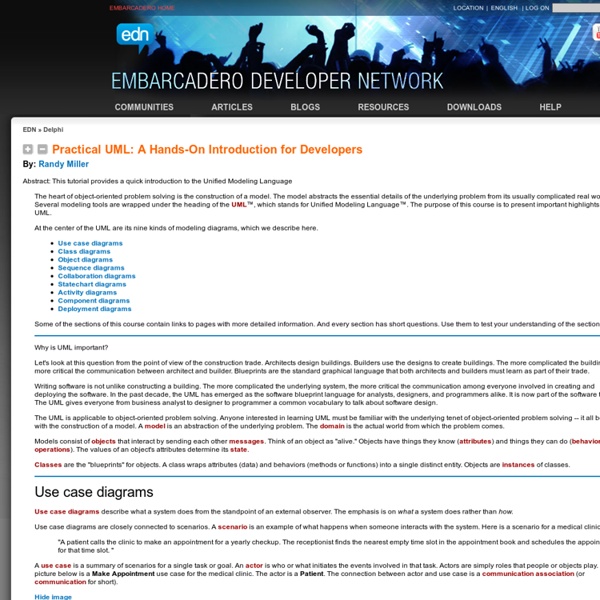Practical UML: A Hands-On Introduction for Developers

UML Tutorial - UML Unified Modelling Language - Sparx Systems
The Unified Modeling Language (UML) has quickly become the de-facto standard for building Object-Oriented software. This tutorial provides a technical overview of the 13 UML diagrams supported by Enterprise Architect. UML 2 semantics are explained in detail in the new UML 2.0 tutorial. Firstly... The OMG specification states: "The Unified Modeling Language (UML) is a graphical language for visualizing, specifying, constructing, and documenting the artifacts of a software-intensive system. The important point to note here is that UML is a 'language' for specifying and not a method or procedure. UML defines the notation and semantics for the following domains: The UML also defines extension mechanisms for extending the UML to meet specialized needs (for example Business Process Modeling extensions). Part 2 of this tutorial expands on how you use the UML to define and build actual systems. See also Business Process Modeling (pdf).
DantotsuPM.com
Voices on Project Management
In my last post, I wrote about the importance of a project schedule plan and the fact that a project schedule is generally constrained by various factors. In this post, I'll take a deeper dive into the three techniques that can be applied to address resource and time constraints. Resource leveling This technique can be applied to a project's schedule plan when the project is facing resource constraints or when you need to allocate resources consistently and most effectively throughout the life cycle (e.g., all resources utilized at 100 percent capacity by project completion). The basic idea behind resource leveling is to recognize tasks, priorities, dependencies and constraints. Logically speaking, resource leveling is applied in this order: Develop the schedule.Consider work tasks, dependencies and constraints.Identify the critical path of your project schedule.Allocate resources. Schedule crashing This technique focuses on the tasks on the critical path. Fast-tracking
Project Management Articles
Kelly's Contemplation
PMTOOLBOX :: Project Management Resources for Managers
Related:
Related:



